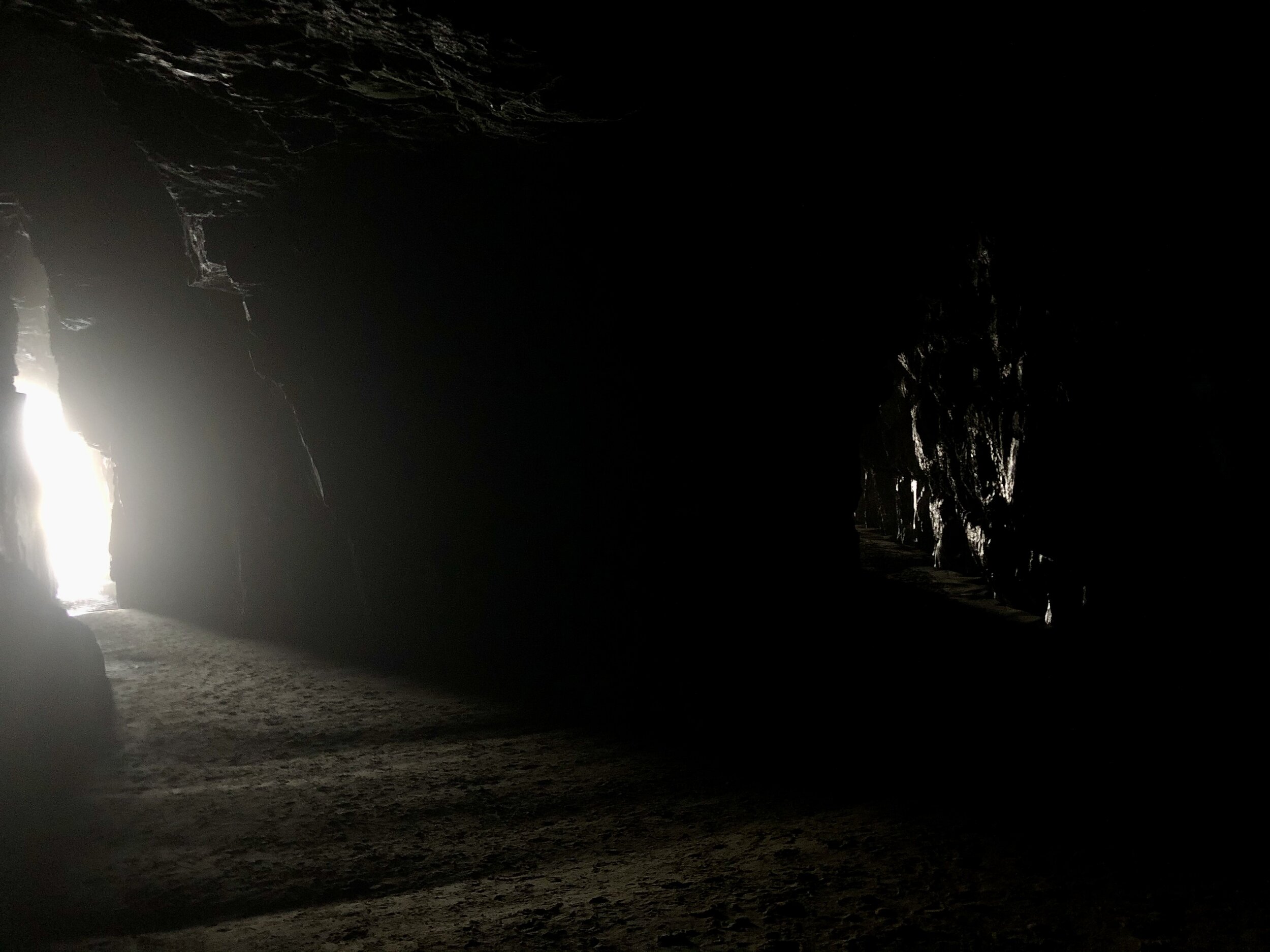Cathedral Caves
Cathedral Caves left me out of breath. In part because of their beauty, but also because 45 minutes were spent sprinting from cave (cathedral) to cave (cathedral) before the tide began to advance. These massive limestone caves are known for their acoustics (dream: an orchestra playing right where I stood in the image below, or perhaps the chanting of Gregorian monks, or the strum of Joanna Newsom’s harp). And indeed, they are reminiscent of old European cathedrals: long, narrow rooms with massive arched ceilings. Altogether, they add up to nearly 200 meters (656 feet) deep and roughly 40 meters (100 feet, or slightly less than 10 stories) high. The caves are only accessible for 2 hours before and after low tide. On this particular day, low tide was at 11:06am, and the carpark closed at 1:15pm. It is about a 1 km hike to get to the beach area, so after arriving around 12:00pm, the tide was already beginning to advance. The race was on!
There are two main caves that most tourists find. BUT, just beyond a rock outcrop, there are even more caves! And then beyond another rock outcrop, there are even MORE caves! [Cut to scene of me sprinting through thigh-level water as it crashed against the rocks and I struggled to keep secure footing.] The most esteemed guidebook, NZ Frenzy, told of wonders beyond the original two caves. I was looking for some magical penguin den (!that I would stay at least 10 meters away from!), or an inner-cave waterfall. But nay! However, there was a cool little trickle of water (see 2nd to last cave picture). And it was fun to sprint as the water receded and then stay perfectly still and brace myself as the water rushed again over my ankles and up my legs. I’m living proof that I survived.
It is worth noting that Cathedral Caves are on "Māori land”. As with many countries colonized by Europeans (and in the case of NZ, largely British subjects), the native people were tricked out of their original land, only to be given the leftover bits of the least desirable parts of the country - the places where it was difficult to make any living off the land (think Cherokee in Oklahoma or Navajo in the four corners region of the US). The Māori too were allocated land that had no real agricultural or economic value, as mentioned by the Cathedral Caves website:
“At the turn of the 20th century, the New Zealand Government decided to reserve land for descendants of Māori who had been adversely affected by Government and private land purchases in the 1840s and 1850s. The South Island Landless Natives Act (SILNA) 1906 was intended to provide redress for the economic hardship afflicting Māori who had lost their customary lands and the means to support themselves. Under the legislation, the Government (Crown) allocated 57,500 ha of land, much of it in southern South Island and Stewart Island, to about 4,000 Māori. At the time of their granting, these SILNA lands were among New Zealand’s least valuable – remote, rugged, wet, unsuitable for farming and often far from traditional home areas.”
Now, the land given to the 4,000 Māori individuals has been divided up into parcels. Precisely 234 Māori descendants own a claim to this particular piece. The highlighted bits in the below image are the particular section encompassing Cathedral Caves.
The 6 highlighted sections make up the “Tautuku Block X Section 3C Trust,” which the 234 Māori have a stake in.
It is worth nothing that the division of the government that oversees the Māori land is the Ministry of Justice…
New Zealand likely has had the most civilized response to their oppression of native people that I have seen anywhere in the world. That is not to say it is perfect. And it is not to excuse the actions of the European settlers. But yet, New Zealand seems like it is actually really trying, and has been quite successful at making amends with the native Māori. For instance, there are dual language signs nearly everywhere you go. “Kia ora” is a common greeting said just as frequently among white people (and is not considered cultural appropriation). Which leads me to consider the next logical question: what if the US took Native American language and culture as seriously as it did European heritage? There is a feasibility argument here: America had hundreds (thousands?) more tribes than New Zealand, with vast linguistic and cultural differences, and to include them all in the mainstream (e.g. dual-language signs, honoring sacred areas) would be nearly impossible (in part because many of those areas no longer exist). But what might be even better? To consult with the descendants of those Native Americans that the US relegated as out-of-sight/out-of-mind. To ask them what they want and what they need. Why New Zealand appears in such stark contrast with the US is simple: NZ chooses to ask and listen to the people whom it has suppressed for over a century and work toward progress (yes, ever-imperfect, but an open dialogue nonetheless).
At any rate, I suspect that no matter who you are or whether or not you know the feel of an ancient European cathedral, you are left with a sense of awe at the cavernous possibilities that crashing waves can create, including a moment to catch your own breath.










